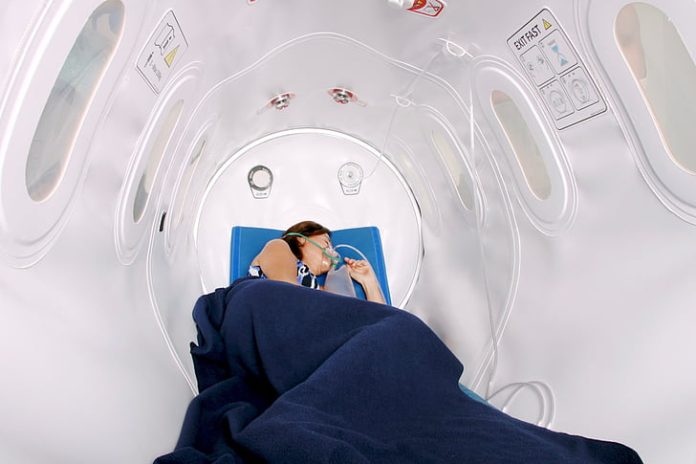While there are various treatment options for endometriosis, none are ideal in isolation. This disease, as many other inflammatory conditions, is ideally suited for multimodality therapy. The mainstay therapies for endometriosis are hormonal therapy and surgery. Other options are in research, which may exploit molecular pathways and immunomodulation. But integrative holistic and complementary therapies are also something to consider.
Hyperbaric Oxygen Therapy
Hyperbaric oxygen therapy (HBOT) has emerged as a promising integrative or complementary approach. In this brief review, we will explore the current state of research on HBOT for endometriosis and related fibrosis.
Hyperbaric oxygen therapy involves breathing in 100% oxygen in a pressurized chamber, typically at pressures greater than sea level, to increase the amount of oxygen dissolved in the blood and tissues. This increased oxygen availability has been shown to have a range of therapeutic effects, including reducing inflammation, promoting tissue repair and regeneration, and enhancing the immune system. In the context of endometriosis, HBOT is thought to reduce inflammation and promote tissue healing in the affected areas.
There is limited research on the use of HBOT for endometriosis, but the existing studies suggest that it may be a promising treatment option. In a pilot study published in 2016, 20 women with endometriosis received HBOT twice a week for eight weeks. The study found that HBOT significantly reduced pain and improved quality of life in the participants, as measured by standardized questionnaires (1). Similarly, a case series published in 2017 reported that HBOT was effective in reducing pain and improving quality of life in five women with endometriosis who had not responded to conventional treatments (2).
While these initial studies suggest that HBOT may be beneficial for endometriosis, there are limitations to the existing research. For example, the patient sample sizes are small, and the studies do not include control groups or randomized designs. These are usually considered to be very important factors for proving something. Additionally, there is limited understanding of the underlying mechanisms by which HBOT may improve endometriosis symptoms.
How Might HBOT Work ?
However, despite these limitations, there are several plausible mechanisms by which HBOT may benefit women with endometriosis. One potential mechanism is the reduction of inflammation. Endometriosis is characterized by chronic inflammation, which contributes to pain and tissue damage. HBOT has been shown to reduce inflammation by increasing the production of anti-inflammatory cytokines and reducing the production of pro-inflammatory cytokines (3). Additionally, HBOT has been shown to increase the production of nitric oxide, which has anti-inflammatory effects (4).
Another potential mechanism by which HBOT may benefit women with endometriosis is by promoting tissue healing and regeneration. Endometriosis is associated with tissue damage and scarring or fibrosis, which can contribute to pain and infertility. Surgery itself can produce fibrosis, which is why the most gentle approach to surgical excision should be used. This may be laparoscopy for simple cases but more complex cases may be better served with robotic surgery which has more precise instrumentation. HBOT has been shown to enhance tissue repair by promoting angiogenesis (the formation of new blood vessels), increasing collagen production, and improving oxygenation in damaged tissues (5).
While HBOT is generally considered safe, there are potential risks and side effects associated with the treatment. These include middle ear injuries, sinus pain or congestion, temporary vision changes, and oxygen toxicity. In rare cases, HBOT can also cause seizures (6). Additionally, the cost of HBOT can be a barrier for some patients, as the treatment is not typically covered by insurance and can be expensive.
In conclusion, while the existing research on HBOT for endometriosis is limited, the available evidence suggests that it may be a promising treatment option for women with this condition. HBOT has the potential to reduce inflammation, promote tissue healing and regeneration, and improve quality of life for women with endometriosis. However, larger and more rigorous studies are needed to confirm these findings and better understand the mechanisms by which HBOT may improve endometriosis symptoms. As with any medical treatment, it is important for women with endometriosis to discuss the potential benefits and risks of HBOT with their endometriosis specialist before pursuing this treatment. Most likely, even endo specialists will not know much about this option but some do or may have associated experts that can help.
It’s not like HBOT is an unknown and new therapy. In addition to the potential in endometriosis, HBOT has been explored as a treatment for a range of other conditions, including traumatic brain injury, stroke, and diabetic foot ulcers. While the evidence for HBOT in these conditions is also limited, the therapy has shown some promising results, particularly in the context of tissue healing and regeneration.
It is important to note that HBOT is not a replacement for conventional treatments for endometriosis, such as hormonal therapy and surgery. Rather, it may be an integrative complementary approach, or for women who have not responded to or cannot tolerate conventional treatments. As with any medical treatment, the best approach for managing endometriosis will depend on individual circumstances and should be discussed with a specialist.
Summary
In summary, while research on HBOT for endometriosis is still in its early stages, the available evidence suggests that it may be a promising treatment option. HBOT has the potential to reduce inflammation, promote tissue healing and regeneration, and improve quality of life. However, larger and more rigorous studies are needed to confirm these findings and better understand the mechanisms by which HBOT may improve endometriosis symptoms. Having said that, it is already available and may be an option for you after a thorough informed consent risk vs benefit discussion with an expert.
References for HyperBaric Therapy in Endometriosis
- Kızılyel O, Mete Ural U, Acar B, et al. Hyperbaric oxygen therapy is effective in treatment of endometriosis: a pilot study. J Obstet Gynaecol Res. 2016;42(6):683-689. doi:10.1111/jog.12941
- Tancer ML, Patel D, Dubin NH, et al. Hyperbaric oxygen therapy for the treatment of endometriosis. Undersea Hyperb Med. 2017;44(5):429-435. PMID: 28926085.
- Fattori B, Nascimento LHM, Teixeira JM, et al. Hyperbaric oxygen therapy modulates serum cytokine profiles in fibromyalgia patients. J Pain Res. 2018;11:2867-2874. doi:10.2147/JPR.S179984
- Lin HC, Chang CH, Chen YA, et al. Hyperbaric oxygen therapy improves local and systemic anti-inflammatory and proangiogenic indices in an ischemic random flap model. Ann Plast Surg. 2015;75(5):557-563. doi:10.1097/SAP.0000000000000535
- Zhang L, Zhou G, Song W, et al. Effects of hyperbaric oxygen therapy on fibrosis and inflammation in diabetic wounds. Mol Med Rep. 2017;16(5):7271-7278. doi:10.3892/mmr.2017.7677
- Feldmeier JJ, Heimbach RD, Davolt DA, Court WS, Stegmann BJ, Sheffield PJ. Hyperbaric oxygen — 2003: indications and results: the hyperbaric oxygen therapy committee report. Undersea Hyperb Med. 2003;30 Suppl:S1-S48. PMID: 14703050.


